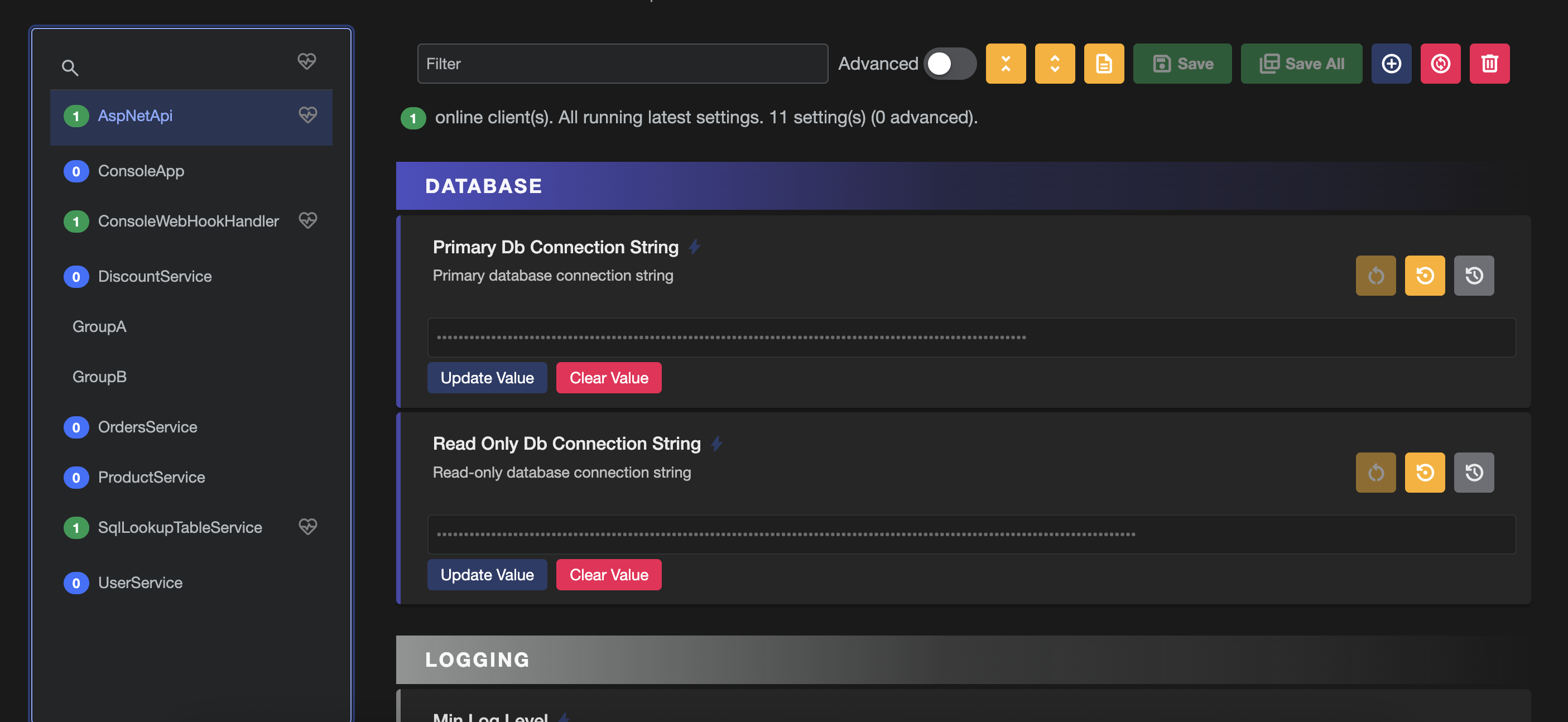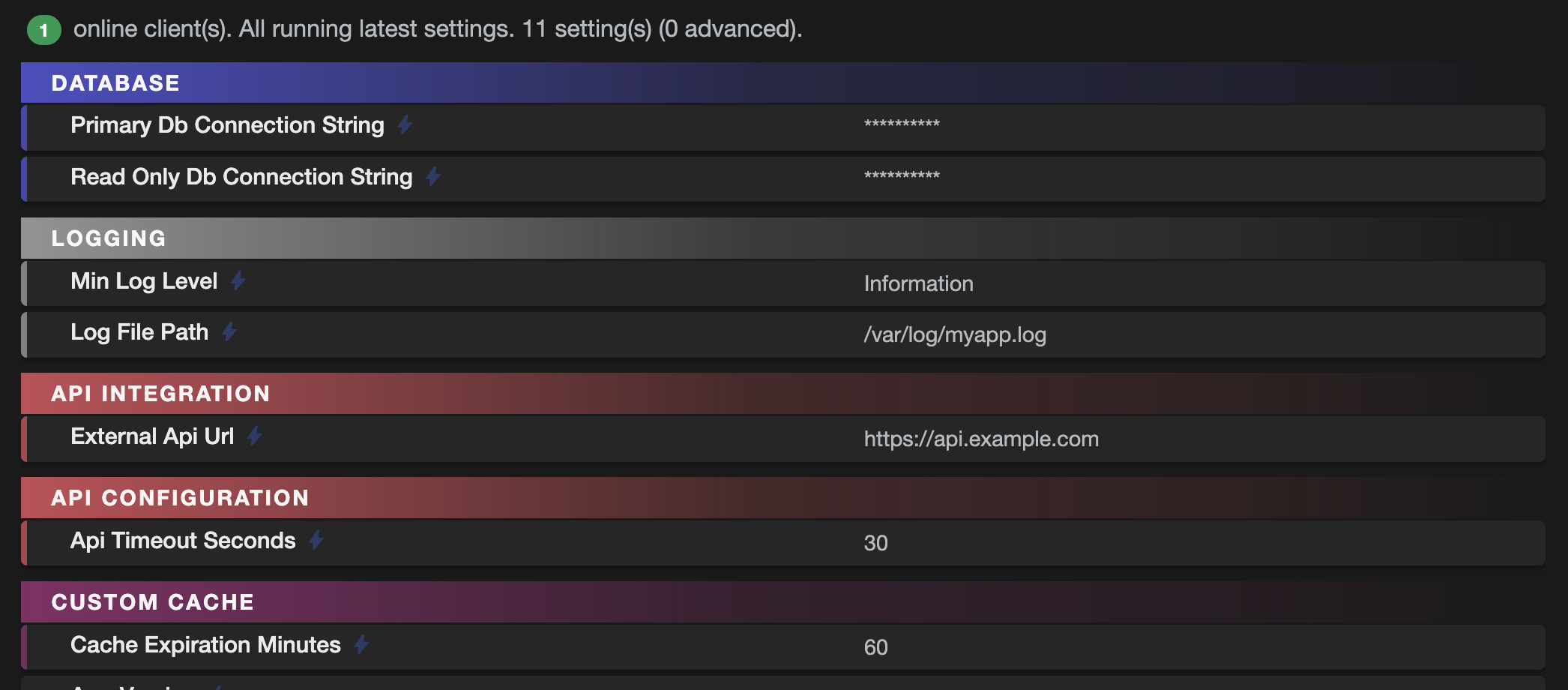Setting Headings
Overview
Headings are visual separators that help organize settings into logical groups in the Fig web UI. They provide visual separation with customizable text labels, indentation, and colors to make settings easier to navigate and understand.
Fig automatically creates headings based on your [Category] attributes. This is the recommended approach as it requires no additional configuration and keeps your code clean. Manual heading attributes are only needed for special cases.

Headings shown above settings

Headings when settings are collapsed
Automatic Heading Creation
By default, Fig automatically generates headings based on the [Category] attribute on your settings. This is the easiest and most maintainable way to organize your settings.
Basic Automatic Headings
public class ApplicationSettings : SettingsBase
{
[Category("Application Configuration")]
[Setting("Application Name")]
public string AppName { get; set; } = "MyApp";
[Category("Application Configuration")]
[Setting("Version")]
public string Version { get; set; } = "1.0.0";
[Category("Database Settings", "#0066CC")]
[Setting("Connection String")]
public string ConnectionString { get; set; } = "";
[Category("Database Settings", "#0066CC")]
[Setting("Timeout")]
public int Timeout { get; set; } = 30;
}
This will automatically create:
- An "Application Configuration" heading above
AppName - A blue "Database Settings" heading above
ConnectionString
Controlling Automatic Headings
You can disable automatic heading generation in your FigOptions:
services.Configure<FigOptions>(options =>
{
options.AutomaticallyGenerateHeadings = false; // Disable automatic headings
});
Only disable automatic headings if you need full manual control. In most cases, the automatic behavior is sufficient and easier to maintain.
Manual Heading Attribute (Advanced)
Manual headings should only be used when:
- You need headings that don't correspond to categories
- You need complex indentation hierarchies
- You have disabled automatic heading generation
- You need special headings
The HeadingAttribute provides manual control over heading placement and appearance.
Basic Manual Heading
[Heading("Database Configuration")]
[Setting("Database Connection String")]
public string DatabaseConnectionString { get; set; } = "Server=localhost";
[Setting("Connection Timeout")]
public int ConnectionTimeout { get; set; } = 30;
Manual Heading with Indentation
[Heading("Authentication Settings", indent: 1)]
[Setting("Username")]
[Indent(1)]
public string Username { get; set; } = "";
[Heading("Advanced Authentication", indent: 2)]
[Setting("Token Expiry")]
[Indent(2)]
public int TokenExpiry { get; set; } = 3600;
Manual Heading with Custom Color
[Heading("Critical Settings", color: "#FF0000")]
[Setting("Enable Debug Mode")]
public bool EnableDebugMode { get; set; } = false;
Advanced Manual Heading
[Heading("Development Tools", indent: 1, color: "#00AA00")]
[Advanced]
[Setting("Enable Profiling")]
public bool EnableProfiling { get; set; } = false;
Parameters
Text (Required)
- Type:
string - Description: The text label displayed in the heading
- Validation: Cannot be null or empty
- Example:
"Database Settings"
Indent (Optional)
- Type:
int - Description: The indentation level for the heading
- Default:
0(no indentation) - Range: 0 to 5 (inclusive)
- Behavior: Each level adds 10px of left margin
- Example:
indent: 2results in 20px indentation
Color (Optional)
- Type:
string - Description: The border color for the heading card
- Default: Inherits color from the associated setting
- Format: CSS color values (hex, named colors, etc.)
- Examples:
"#FF0000","red","rgb(255,0,0)"
Behavior
Visual Appearance
- Headings appear as cards above their associated settings
- Similar in size to collapsed setting cards
- Text is left-aligned within the card
- Cannot be collapsed, expanded, or modified
- Border color matches the specified color or inherits from the setting
Inheritance
- Color: If no color is specified, the heading inherits the color scheme from its associated setting
- Advanced: Headings automatically inherit the advanced setting status from their associated setting
Advanced Settings Integration
- If a setting is marked as
[Advanced], its heading is also treated as advanced - Advanced headings are hidden when advanced settings are hidden
- No need to separately mark headings as advanced
Indentation
- Follows the same indentation system as the
[Indent]attribute - Indentation is applied as left margin:
level * 10px - Maximum indentation is 50px (level 5)
- Independent of the associated setting's indentation
Validation
- Text: Must not be null or empty (
ArgumentExceptionthrown if invalid) - Indent: Must be between 0 and 5 inclusive (
ArgumentOutOfRangeExceptionthrown if invalid) - Color: No validation applied - invalid CSS colors will fall back to default styling
Examples
Recommended: Using Automatic Headings with Categories
public class ApplicationSettings : SettingsBase
{
[Category("Application Configuration")]
[Setting("Application Name")]
public string AppName { get; set; } = "MyApp";
[Category("Application Configuration")]
[Setting("Version")]
public string Version { get; set; } = "1.0.0";
[Category("Database Settings", "#0066CC")]
[Setting("Primary Database Connection")]
public string PrimaryDbConnection { get; set; } = "";
[Category("Database Settings", "#0066CC")]
[Indent(1)]
[Setting("Max Pool Size")]
public int MaxPoolSize { get; set; } = 100;
[Category("Database Settings", "#0066CC")]
[Indent(1)]
[Setting("Min Pool Size")]
public int MinPoolSize { get; set; } = 10;
[Category("Database Settings", "#0066CC")]
[Advanced]
[Indent(1)]
[Setting("Enable Query Logging")]
public bool EnableQueryLogging { get; set; } = false;
}
This automatically creates:
- An "Application Configuration" heading above
AppName - A blue "Database Settings" heading above
PrimaryDbConnection - Advanced settings are handled automatically
Mixed Approach: Automatic + Manual (When Needed)
public class MixedSettings : SettingsBase
{
// Automatic heading from category
[Category("Security Settings", "#FF6600")]
[Setting("API Key")]
public string ApiKey { get; set; } = "";
[Category("Security Settings", "#FF6600")]
[Setting("Encryption Key")]
public string EncryptionKey { get; set; } = "";
// Manual heading for special cases
[Heading("Custom Actions", color: "#FF0000")]
[Setting("Enable Custom Feature")]
public bool EnableCustomFeature { get; set; } = false;
}
Notice how the automatic approach using [Category] is much cleaner and requires less code than manual [Heading] attributes.
Manual Only (When Automatic is Disabled)
Only use this approach when you've disabled automatic headings:
public class ManualHeadingSettings : SettingsBase
{
[Heading("Application Configuration")]
[Setting("Application Name")]
public string AppName { get; set; } = "MyApp";
[Setting("Version")]
public string Version { get; set; } = "1.0.0";
[Heading("Database Settings", color: "#0066CC")]
[Setting("Primary Database Connection")]
public string PrimaryDbConnection { get; set; } = "";
[Heading("Connection Pool", indent: 1, color: "#0066CC")]
[Setting("Max Pool Size")]
[Indent(1)]
public int MaxPoolSize { get; set; } = 100;
[Setting("Min Pool Size")]
[Indent(1)]
public int MinPoolSize { get; set; } = 10;
[Heading("Advanced Database Options", indent: 1, color: "#0066CC")]
[Advanced]
[Setting("Enable Query Logging")]
[Indent(1)]
public bool EnableQueryLogging { get; set; } = false;
}